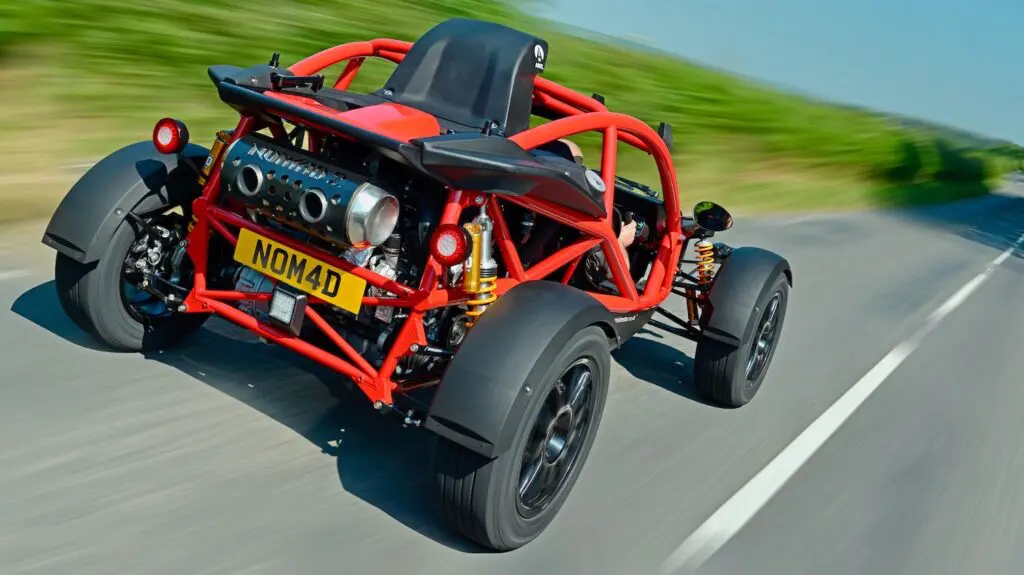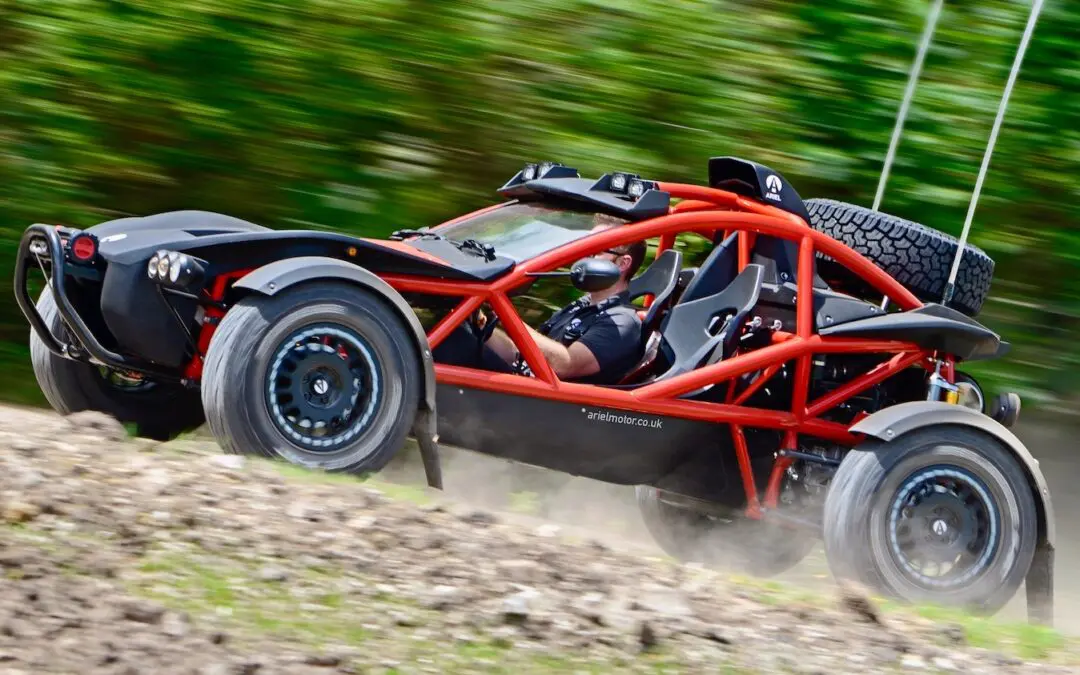Launching the all-new Ariel Nomad 2, ARIEL Motor Company, based in Crewkerne, Somerset is a low-volume producer of ultra-lightweight road, track, and off-road cars.
Ariel’s second-generation Nomad is appropriately called “Nomad 2.” Now in its fourth iteration, the Nomad develops and upholds Ariel’s basic principle of “serious fun,” therefore reflecting the company’s approach of form following function. The Atom sports car is also evolving.
Exposed outboard suspension, long travel dampers, damage resistant body panels, increased air intake and a hose out interior clearly shows the off-road prowess of the Nomad, also known as the Atom’s “Mucky Brother”.
Although the Nomad 2 is a clearly identifiable variation of the original, when comparing both cars, the evolving design language is obvious.
Based on lessons from the initial car, combines user comments, and gains from major Ariel R&D, the all-new ground-up design Nomad 2 only has three carry-over pieces.
“The all-new Nomad 2 is the sum of our 25 years of automotive experience, a decade of Nomad feedback and the latest learning from Atom 4, said Henry Siebert-Saunders, Ariel MD.
“Pouring all this information into Nomad 2 guarantees it is faster and more capable than before. Fast! The Nomad 2 is indeed the best way to go anywhere, on road or off it, fast!”
Designed and engineered by the internal Ariel team, the Nomad 2 boasts a new chassis, suspension, steering and brakes, electronics, fresh bodywork with notable aerodynamic enhancements, new seats and instrumentation, coupled with a plethora of design tweaks and improvements.

The Nomad 2 marks a significant development in the history of the Nomad and Ariel itself, with an open design mandate to improve the automobile everywhere feasible.
Ariel aimed to increase the accessibility of the Nomad 2’s performance so that users may boldly explore its whole range of capabilities.
Designed to operate both on- and off-road, the new model has choices of completely customisable driving aids including a three-stage engine map controller, user adjustable launch and traction control, and an adjustable ABS system.
Every change can be performed on the road, so allowing the driver total control over settings.
From racetracks to rally stages, in blazing heat, monsoon rain, floods, dirt and snow, the Nomad 2 has seen the most extreme test schedule to date.
Ariel director Simon Saunders said: “Making lightweight cars behave compliantly and comfortably on the road is an artform given suspension loads and forces are so low.
“This takes it to another level to make the same automobile competent of consistently and repeatedly jumping the summit of an off-road slope at more than 100mph. You will value the extremes we have dealt with if you then add loose surfaces, mud, water, maybe some ice.
“Even to us, The Nomad 2 is a quite amazing vehicle. As always, we have included all the components consumers desire: beach buggy fun, rally car performance and dynamics, road car refinement and dependability.
“You can drive this car to the stores and then around a WRC gathering point. Above all, though, our guiding idea is that the trip will make you smile.
Every Nomad 2 will be manufactured to order by a single mechanic who takes the car from bare chassis to final test drive before signing off and adding their personal nameplate as with all Ariels.
With almost a hundred choices, Ariel can customise every Nomad to client’s specific needs, therefore guaranteeing no two cars will be the same.
Together with the Ariel Atom 4, Atom 4R, and Dash e-bike, production of Nomad 2 is scheduled to start at the Ariel plant close to Crewkerne in Somerset.
With substantial learning from the first Nomad and more recently from the Atom 4, Nomad 2 is based on a new tubular chassis created in-house by the Ariel engineering and design team.
Each of the larger (63.5mm and 51mm) main and diagonal tubes used in this Nomad has been examined and refined to produce a light yet remarkably sturdy construction.
More than 60% of the torsional stiffness of the chassis has been added compared to the original Nomad, therefore providing great structural rigidity.
The chassis exceeds the requirements of a full frontal 50kph barrier impact, seat belt pull, and rear impact test by including built-in roll-over protection, therefore providing a complete safety cage for very high degrees of occupant safety.
Sophisticated CAD (Computer Aided Design), FEA (Finite Element Analysis) design work, laser cut components, bronze-welded CNC (Computer Numerical Control) formed tubes, epitomises Ariel’s approach and gives a quality only feasible in low volume production.
The Nomad 2 entry/egress opening is bigger than the original, and a longer wheelbase gives greater cockpit area. Chassis undergo a three-stage finishing process including phosphating, powder coating to colour preference, and then powder coating lacquer.
The new Ford 2.3-liter, four-cylinder, direct injection, 16-valve, dual spool turbocharged engine forms the backbone of the Nomad 2. Derived on the Focus ST, Ariel has tweaked the engine to produce amazing 518Nm of torque and up to 305bhp.
Ariel mapped the Nomad 2’s on- and off-road needs to a switchable ECU that lets drivers select from three distinct engine maps, producing 260bhp/385Nm, 302bhp/451Nm, or 305bhp/518Nm.
The maximum setting produces far greater torque over the rpm range, both on and off-road, therefore attaining ultimate performance.
Driving through a six-speed manual gearbox with limited slip differential, the Nomad 2 offers huge ability off-road but passenger car driveability on-road.
Derived from the Atom 4 and Atom 4R, adding a hydraulic handbrake, the Nomad 2 takes Ariel’s ultimate performance concept to a new height for off-road, high-performance driving with the option of a six-speed paddle change gearbox.
Together with a dual engine air filter system to handle negative operating circumstances off road, the air intake system includes an enclosed air-to– air intercooler sheltered from off-road debris.
Separately to the engine intake system, clean air is piped from the roof intake to the intercooler where a pre-filter removes any debris before a three-layer filter removes any finer particles.
Collected dirt or moisture finds a sump in the system where it is subsequently discharged by a vacuumuator valve. Ultra-severe conditions call for a further WRC standard filter.
Featuring a ceramic honeycomb, high palladium/rhodium content catalytic converter, and a twin outlet stainless silencer, the 75mm diameter stainless system exhaust system is built to meet EUCSSTA (European Community Small Series Type Approval) noise and emission criteria as well as racecourse noise levels.
Two and a half times the size of that in the first Nomad, a larger radiator fits to stretch Nomad 2’s capacity into ever more hostile and hotter surroundings.
Longer trips into the future call for a fuel capacity of 70 litres, a 40% boost over the previous model, therefore providing a range of more than 550 miles.
Knowledge and experience of building lightweight cars that handle properly on and off-road as well as in competition allows Ariel to see the Nomad 2 achieve an ideal mix of on-road compliance while preserving wheel contact and suspension travel off-road.
The all-new chassis sees the wheelbase stretched (+48mm) and track raised (+50mm), hence improving high speed stability off-road. The Nomad 2 has the capacity and performance to cover any terrain since the approach angle (48 degrees) and departure angle (64 degrees) greatly exceed normal off-roaders.
Featuring double, unequal length, wishbones with direct-acting outboard dampers, Nomad 2 has completely changed suspension and steering geometry in addition to increasing suspension travel over the original Nomad.
The new design includes anti-dive and anti-squat geometry based on 10 years of constant growth from Ariel and design advice from suspension master Richard Hurdwell.
Particularly helpful off-road to improve grip, this prevents weight transfer under acceleration and braking and preserves balance and tyre contact. With specific attention to caster tuning to provide accuracy on- and off-road as well as more communicative driver feedback, a redesigned steering rack and new geometry is integrated given the performance enhancements.
Fitted as standard with Eibach dual rate springs, K-Tech coil-over aluminium dampers designed especially for the Nomad 2 Offering external piggy-back reservoirs and individual three-way adjustability for rebound, high-speed compression, and low-speed compression, Ohlins TTX dampers and springs are available.
Bilstein two-stage dampers with remote reservoirs offer still another off-road, full race choice.
Now fully sealed rubber bushes and ball joints both inboard and outboard suspension points help to prevent dust and dirt ingress, therefore lowering wear and maintenance.
Because of the improved performance, the new standard braking system grows in size by 40% over the original Nomad; with an AP four-piston calliper and 290mm vented disc all around from the Ariel Atom 4.
Apart from a hydraulic handbrake for off-road applications, the twin circuit system offers cockpit adjustability to change front/rear brake bias on the run.
Standard fitting throughout is stainless braided hose for both brake and clutch hydraulic systems.
One option is a driver adjustable, EU-compliant ABS system with selectable road and off-road settings. Derived from the Atom 4 technology, cockpit-driven launch and traction control is likewise added to the Nomad 2 but adjusted for off-road use as well tarmac.
Whatever the usage, the Nomad 2 is accessible with a wide choice of wheels and tyres to guarantee optimal and consistent performance.
Made especially for the Nomad 2, there are three distinct wheels ranging from the conventional 16-inch alloys, to 18-inch lightweight forged, to 16-inch Beadlock choices.
Covering the whole spectrum of Nomad 2 use situations, the wheels can be equipped with a selection of tyres from road and all-terrain, to off-road and trackday.
Bodywork is a blend of materials chosen especially for the Nomad 2 and its driving environment, on- and off-road. Rotationally moulded in self-coloured, hardened polyethylene are contactable body components including front end, rear covers, and mudguards as well as header, intake and interior panels.
The same technique applied in the production of road cones and boat fenders is used in the robust, practically unbreakable panels made from the original Nomad.
Other body parts include front and rear load coverings are self-coloured composite with carbon fibre alternatives, with a “bikini roof cover” option for UV protection.
One immediately notes the elevated intake snorkel above the passenger cabin. Designed for the sometimes hostile surroundings the Nomad works in, it supplies clean air to intercooler and engine independently and is the result of significant design and CFD (Computed Fluid Dynamics) study.
conducted on the Bramble cloud-based platform the complicated aerodynamics feed air from the front header rail into the air intake.
Controlling air flow over the car necessitated overcoming several problems given the open chassis of the Nomad. An inverted wing, the header rail points air towards the intake.
Air is let to bleed through and beneath the header rail to maintain airflow attached before entering the intake continuously, therefore avoiding disturbance from the open top.
While warm air, leaving the radiator ducts, is driven away, vertical fins on top of the header channel direct cool air to the intake.
Acting as a sun visor and a mounting point for the LED roof lights, the header rail serves still another use. Twin quick-release illuminated whips can be optioned at the back of the car to provide more vision in distant off-road conditions in addition to the basic LED lights.
Quickly removeable, waterproof baggage boxes, up to two bicycles, loose bags, a spare wheel, or a mix of goods can all be carried on an adjustable rack system at the rear of the car.
There is a Warn Axon winch at front with a 1,588 kg load rating. For best off-road protection in even the most extreme environments, the winch nestles in a front winch bumper with matching rear bar and full underbody panels.
The Nomad’s cockpit is built to be washed out; there are floor drain holes to let water out, and no material trim. Designed with supportive wings and the possibility to fit full race harnesses with crutch straps for competition or serious off-road use, the two lightweight seats resemble those first seen in the Atom 4.
There are two seat widths and carbon-fibre alternatives.
While instrumentation is via a full colour TFT display unit designed for the Nomad by AIM Technologies, new switchgear is everything within reach of the 305mm diameter steering wheel with two rotations lock to lock. While there is provision for real time data collection and storage to a Compact Flash Card, the instruments incorporate gear shift LEDs and show gear position via several scrollable menus.
Reverse selection causes a rear camera to automatically activate and display the rearward view on the TFT screen.
Nomad 2’s redesigned electrical arrangement uses a PDM (Power Distribution Management) system instead of several fuses, relays, and a big fuse box.
The PDM system constantly watches the whole electrical system of the car via programmable limit channels, turning off and back on specific circuits as needed. When working in really hostile and demanding environments, this function is quite helpful.
With a 0-60mph timing of 3.4 seconds and top speed of 134mph, Nomad 2 has also improved its performance over the previous car. The Nomad 2 is optimised for ultra-fast in-gear times and a wide and predictable torque range given its great performance potential on- and off-road.
Nomad 2 costs £56, 660 + VAT in the UK (£67,992 inc.). Although fixed price servicing is once yearly, mileage and competition/off-road use also affect it.
Low running costs come from Ariel’s famed dependability and usage of Original Equipment including consumables and oil filters.
Since the very first Atom, the amazing residuals that all Ariels have enjoyed remove depreciation as the main expense in any car ownership; Ariels regularly maintain most, if not all, of their initial cost.
Saunders said: “Recently, as we lacked an Atom 1 for our exhibit, we personally witnessed the intensity of Ariel residuals first hand. Purchasing it back-dated cost more than its initial selling price!.”
Every Nomad 2 is infinitely configurable to its owner from about 100 choices. A significant component of the personalised ownership experience, the Ariel team spends a lot of time with every client going through and consulting on every element of the vehicle.
“Every customer should have the car that fits them,” Ben Gunn, Ariel sales manager, stated.
“Our owners join the Ariel family, hence it is a close relationship and above all we want them to be happy. We spend time ensuring the car is exactly suited for each owner, from those who want a basic fun car to those who want a full-on racer and many in between.
“Our cars are all very serious, greatly capable, ultra-high-performance vehicles but, whatever the use, the bottom line is putting the passion back into driving and having fun.”
Find out more about the Ariel Motor Company CLICK HERE
RECENT POSTS
From the Chair: January 2025
A message from our ChairmanHello again – hope you are all well. I just want to give you a quick update on this year’s…
How the Western Group helps the car industry celebrate its successes
Did you know that two of our members are judges in two of the most prestigious awards panels? Last week I was honoured to…
Continue Reading How the Western Group helps the car industry celebrate its successes
A ‘Sunday Sleepover’ to kick off 2025
A group of us met up for a post-Christmas bash at Stanton Manor Hotel near Chippenham on Sunday, January 12. It’s always lovely to…




